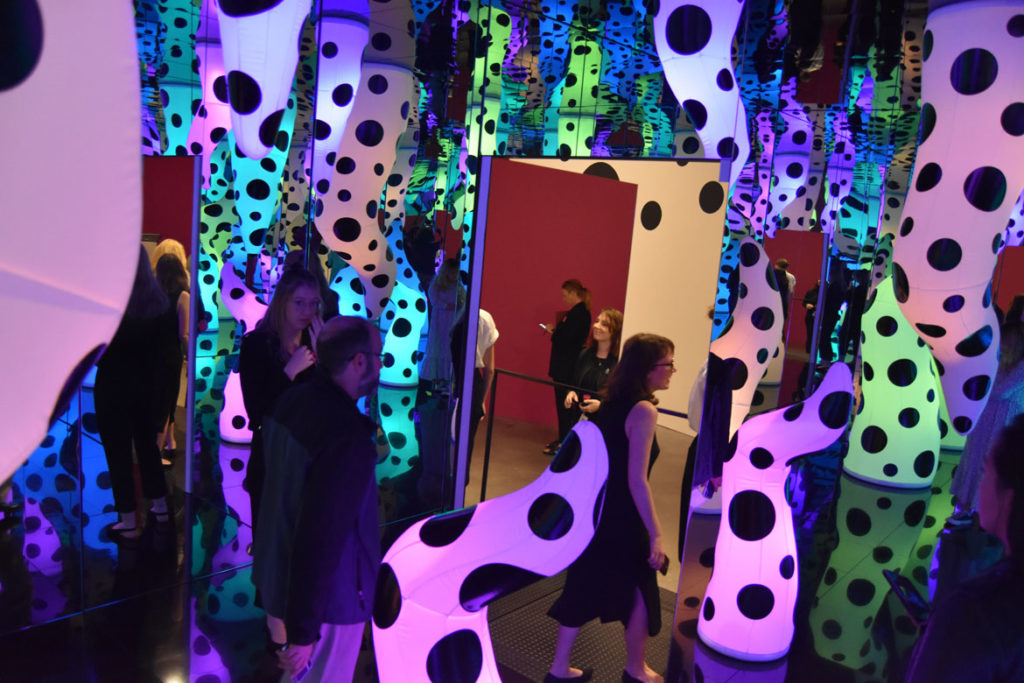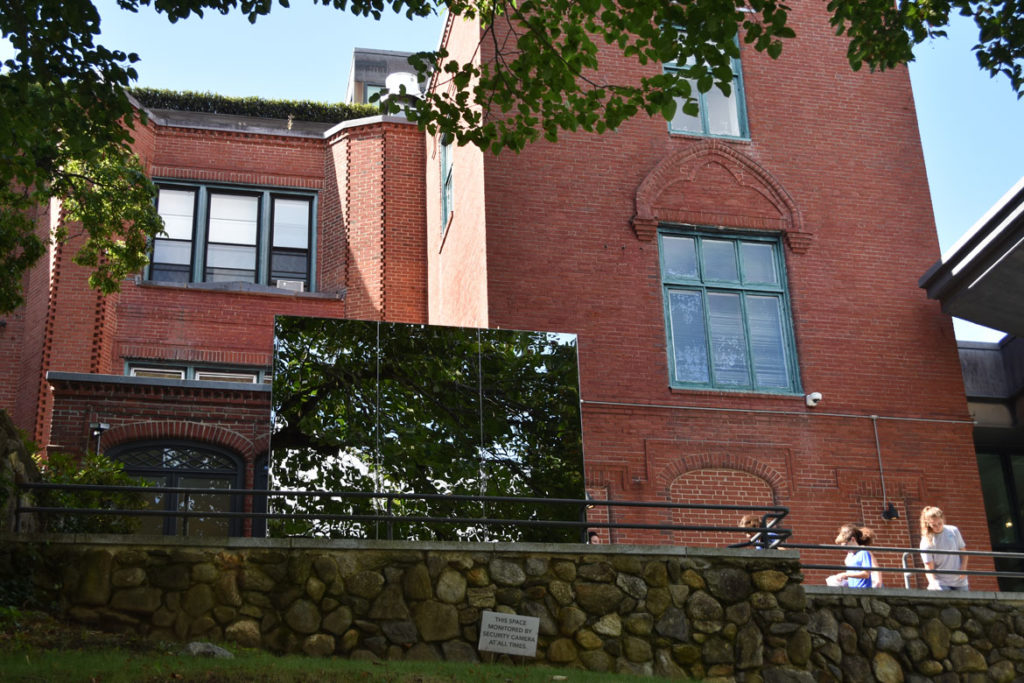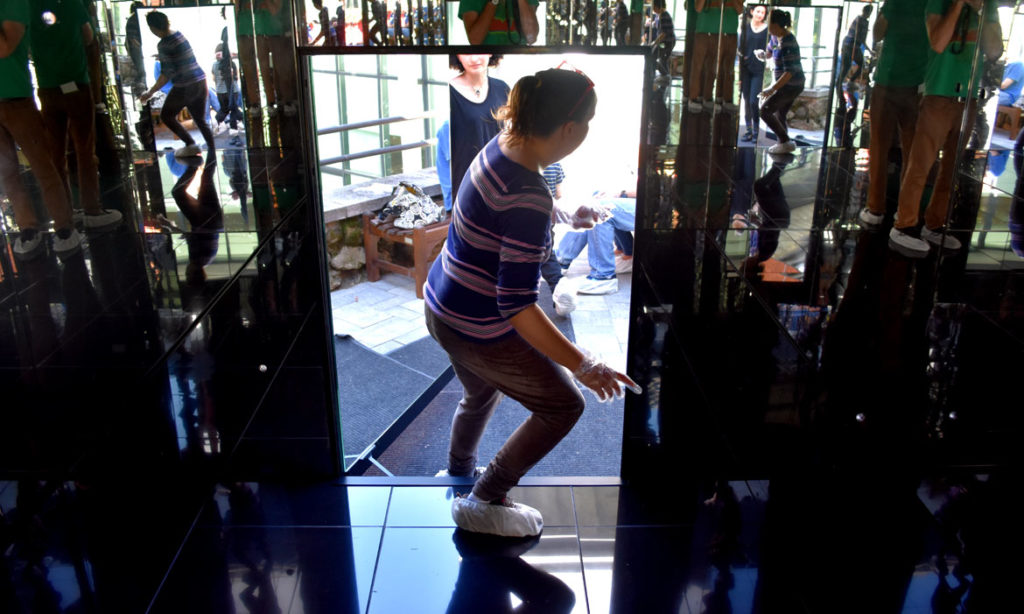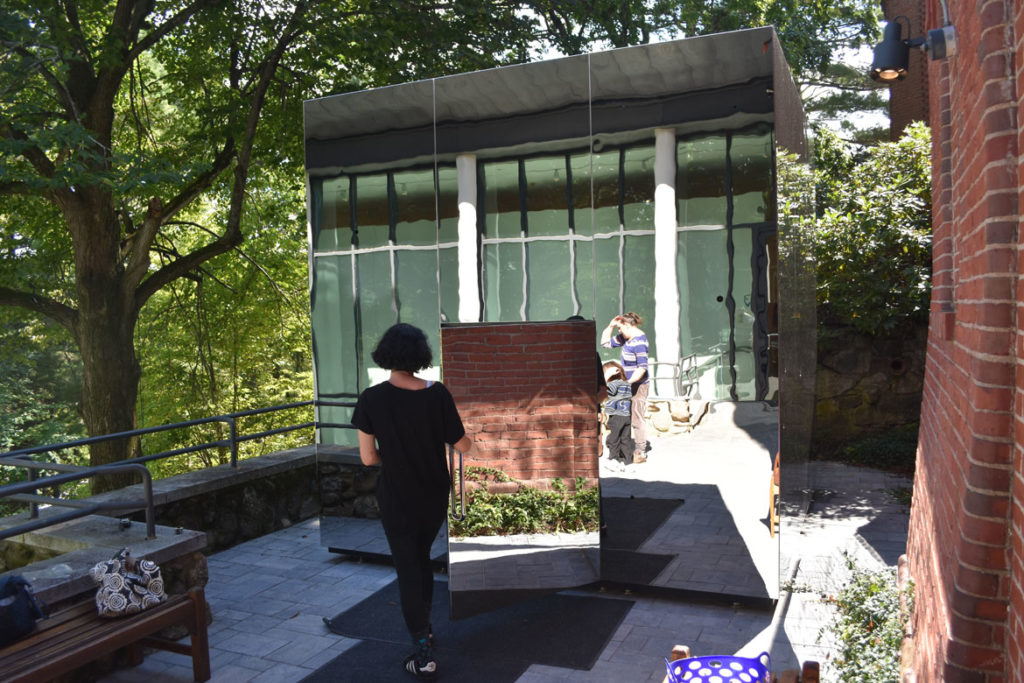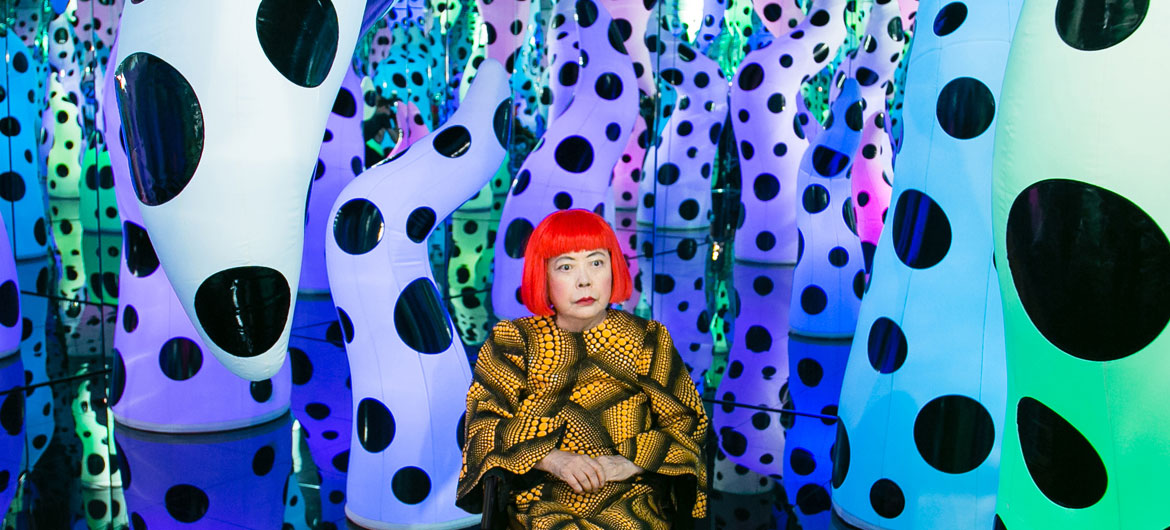The mirrored door of the white box opens and you enter into Yayoi Kusama’s universe. Polka dotted tentacles, lit from within with changing rainbow hues, curl down from the shiny black, 14-foot-high ceiling and up from the shiny black floor. The walls of “Love Is Calling” (2013)—the 90-year-old Tokyo artist’s “Infinity Mirror Room” that will be at Boston’s Institute of Contemporary Art from Sep 24, 2019, to Feb. 7, 2021—are mirrored so this psychedelic vision repeats to (seemingly) forever. Kusama’s disembodied voice declaims a poem in Japanese that translates as “Residing in a Castle of Shed Tears.” Your ticket gives you two minutes inside.
“Being in love with and longing for you, I have locked myself up in this ‘castle of shed tears’ / Now may be the time for me to wander off into the place, the guidepost to the other world points to / And the sky is waiting for me, attended by numerous clouds,” Kusama recites in Japanese. “…Over many long years, with art as a weapon / I have treaded the path in search of love / During the days I have lived through keeping ‘despair,’ ’emptiness’ and ‘loneliness’ all to myself along the way there were times when the fireworks of life “splendidly” adorned the sky.”
Kusama said of her art in a 1964 radio interview: “It arises from a deep, driving compulsion to realize in visible form the repetitive images inside of me.”
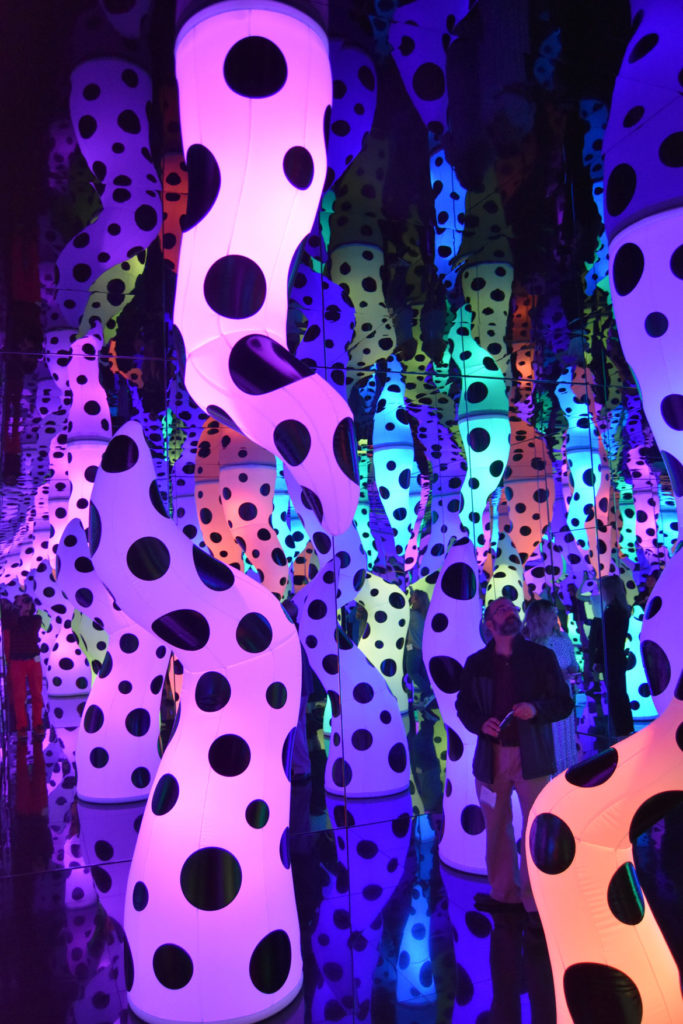

Kusama was born in 1929 and grew up on her wealthy family’s seed nursery in Matsumoto, Japan. When she was 10, she had the first of the hallucinations that she would experience all her life.
“One day, looking at a red flower-patterned table cloth on the table, I turned my eyes to the ceiling and saw the same red flower pattern everywhere, even on the window glass and posts,” Kusama recalled in a 1993 interview. “The room, my body, the entire universe was filled with it, my self was eliminated, and I had returned and been reduced to the infinity of eternal time and the absolute of space. … If I did not get away from there, I would be wrapped up in the spell of the red flowers and lose my life.”
Her hallucinations were part of what she has described as “obsessional neurosis” and “depersonalization. Everything I looked at became utterly remote.” She explained in 1975: “The only way to free myself from them was to control myself—by visually reproducing on paper with pencils or paints, or by drawing from memory these ‘nondescript’ occurrences, which brightened or darkened in the deep of the sea, agitated me and drove me to angry destruction, as I tried to find out what these frightening monsters really were.”
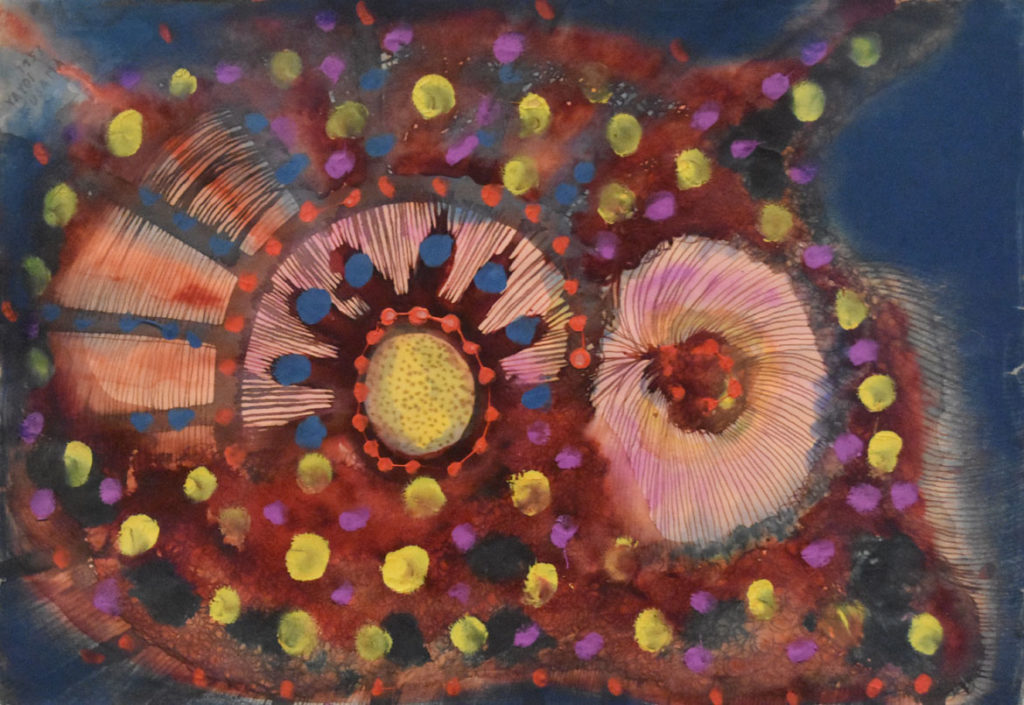
She painted prickly surreal scenes in the 1940s and ‘50s that evolved into abstractions resembling hairy microscopic cells. She traveled to Seattle in late 1957 to exhibit her watercolors and pastels (“Several of the smaller works are beautiful, but one must study them closely to realize the intricacies of their microscopic worlds,” the Seattle Times opined), then the following summer moved to New York.
“The art world in Japan ostracized me for my mental illness. That is why I decided to leave Japan and fight in New York,” she told Akria Tatehata for her 2000 monograph “Yayoi Kusama.” “The first thing I did in New York was to climb up the Empire State Building and survey the city. I aspired to grab everything that went on in the city and become a star.”
In New York, she filled canvases with little circles. These “Infinity Net” paintings were obsessive, minimalist versions of the Abstract Expressionist paintings that then dominated the white Western art world. Some grew more than 30 feet long. “This endless repetition caused a kind of dizzy, empty hypnotic feeling,” Kusama said in a 1964 radio interview.
“I paint them in quantity,” Kusama said another time. “In doing so, I try to escape.”
Around 1962 and ’63, she began sewing and stuffing phalluses. She covered coats with them and shoes and chairs and a rowboat and whole rooms. The circles of her paintings turned into red dots and she covered everything with them.
“Yayoi Kusama has created a surrealist couch and chair, which have broken out frighteningly in what look like thousands of blanched frankfurters,” Brian O’Doherty wrote in The New York Times about her June 1962 Green Gallery exhibition.
Kusama has said the critic and minimalist sculptor Donald Judd, whom she described as “my first boyfriend,” “helped me make the stuffed phalluses from bed linen.” She was also romantically involved with Joseph Cornell, who sometimes financially supported her by giving her artworks to sell.

Kusama’s May 1964 exhibition at Castellane gallery, Grace Glueck reported in the New York Times, “consisted of a roomful of furniture abloom with giant white plaster protuberances—thousands and thousands of fungus-like sacs attached to such mundane objects as pots, a dustpan, an ironing board, a couch and so on. Miss Kusama has also strewn the gallery floor (and festooned some manikins) with shards of uncooked macaroni which cracked underfoot and crept into visitors shoes.”
“I have obsessions,” Kusama told Glueck. “I feel absolutely driven to make visible the repetitive images inside of me. The macaroni, for instance, expresses my food compulsion. When I was a child, I used to tear clothing, papers, books into thousands of pieces. I fluctuate between feelings of reality and unreality.”
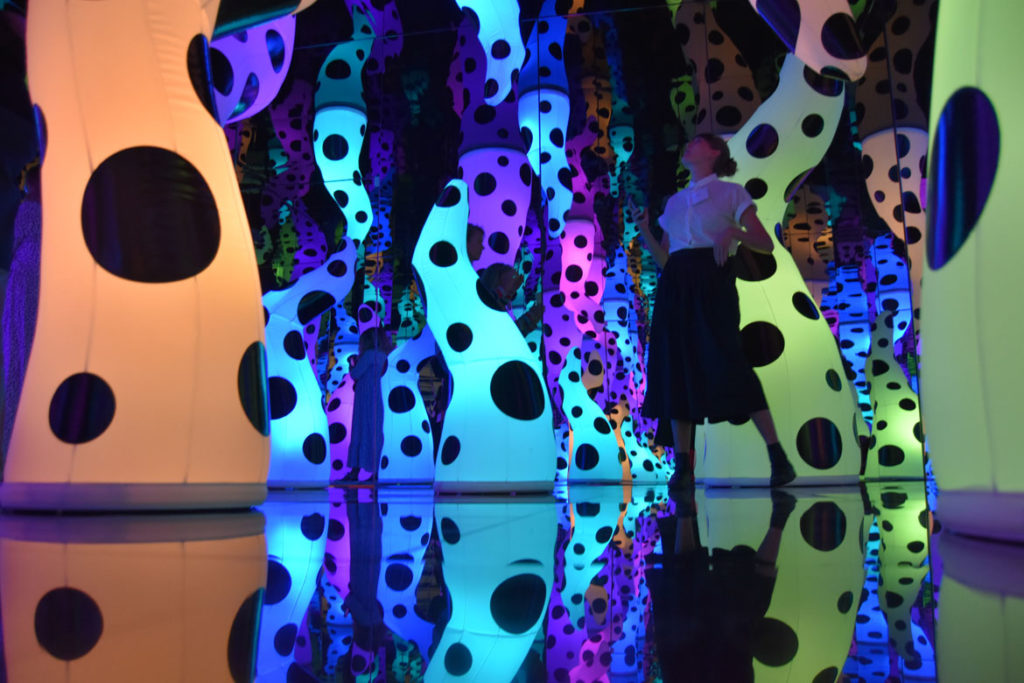
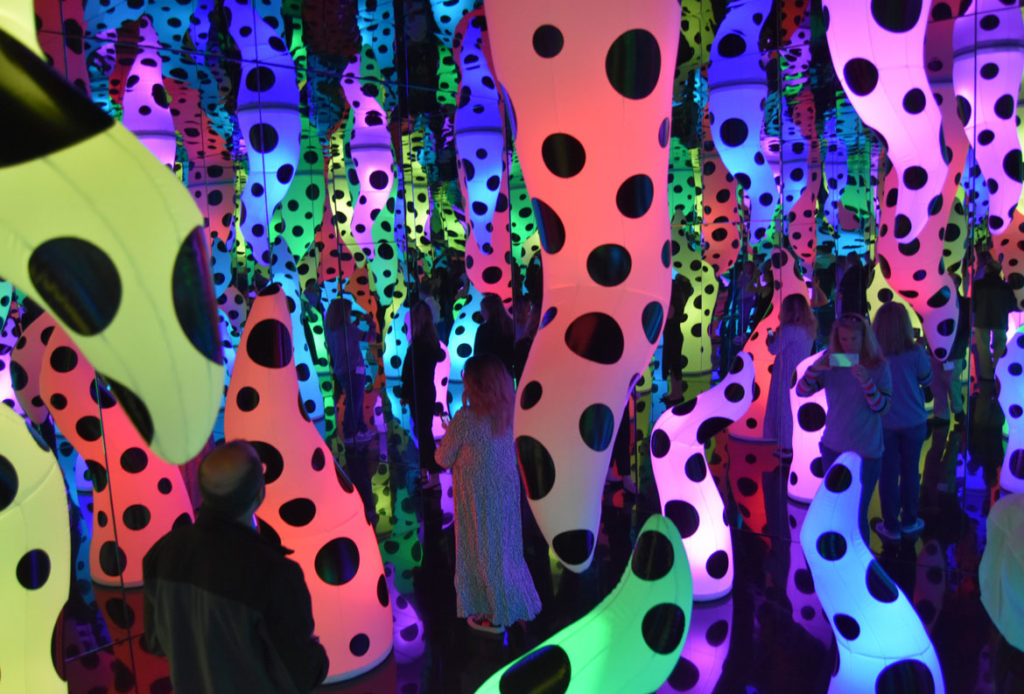
If this is the kind of coverage of arts, cultures and activisms you appreciate, please support Wonderland by contributing to Wonderland on Patreon. And sign up for our free, weekly newsletter so that you don’t miss any of our reporting.
Endless Love
“Love Is Calling” is one of 20 “Infinity Mirror Rooms” that Kusama has made over the years. She created the first in 1965, called “Infinity Mirror Room (Phalli’s Field).” She filled the floor of the mirrored space with hundreds of red and white polka dot phalluses. As Kusama described it, she invited visitors to “walk barefoot through a phallus meadow, becoming one with the work and experience their own figures and movements as part of the sculpture.”
“Kusama’s Peep Show: Endless Love Show” from 1966 invited visitors to stick their heads in one of two windows into a hexagonal mirrored room aglow with blinking colored lights accompanied by music by The Beatles. “An electric monument to love itself,” Kusama said.
When “Peep Show” was included in the ICA Boston’s April 1966 exhibition “Multiplicity,” Edgar Driscoll Jr. wrote in The Boston Globe: “It is a huge box-like creation made up of seemingly thousands of mirrored panels, flashing, multi-colored light bulbs and reflections of the viewer as he peers through small windows into this winking, blinking wonderland. This construction is both beautiful when all lit up or when the lights go off and darkness descends. In this one, repetitions as to numbers are literally uncountable. Here repetitive light patterns extend in all directions to infinity.”
The ICA’s current companion exhibition “Beyond Infinity: Contemporary Art After Kusama” aims to place Kusama in the context of Western fine artists—New York minimalists of the 1960s and ‘70s and razzle-dazzle artists of the past couple decades. One could also draw connections between Kusama’s immersive art and 1960s West Coast psychedelic posters, light shows and Light and Space Art (like Larry Bell’s mirror mazes).
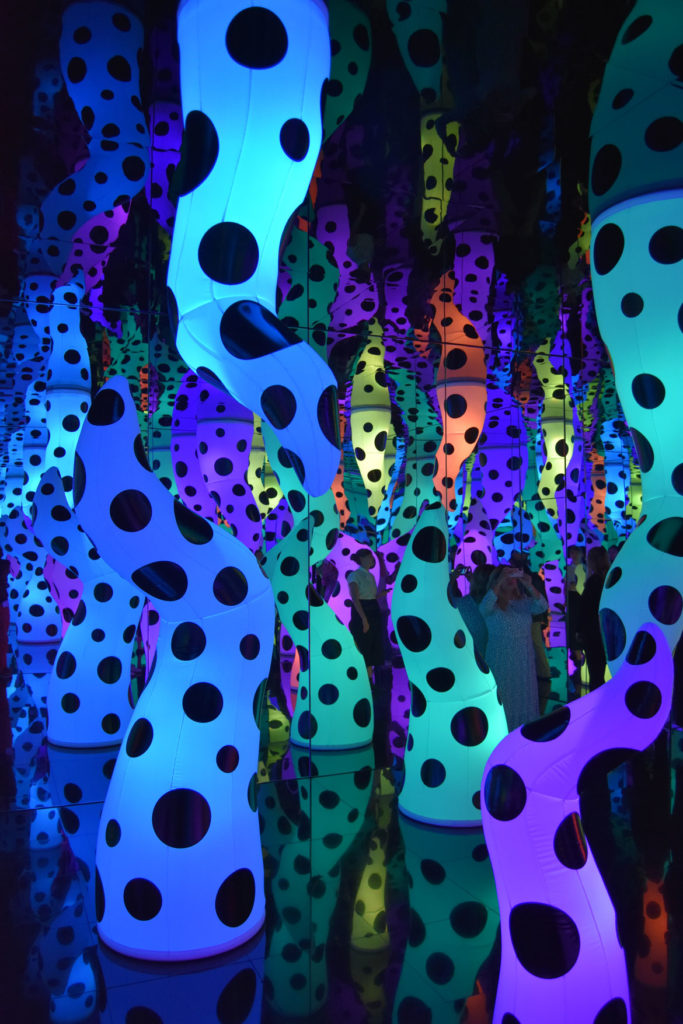
But Kusama’s art perhaps has greatest kinship with the long tradition of visionary artists—often operating outside the fine art world. At the “Magic Gardens” in Philadelphia, Isaiah Zagar invites you to tour patios and pathways that he’s completely and dazzlingly covered in mosaics, including thousands of shards of broken mirrors. At the late Howard Finster’s “Paradise Gardens” in Georgia, there’s an elevated shack, like a guard tower or hunting blind, totally covered inside and out with mirrors. The outside reflects the swampy garden below. Step inside and you get a feeling of vertigo, as if you might fall right through the infinite reflections on the floor.
What Kusama and these other visionary artists share is a desire to remake the world so as to make their visions and dreams manifest. They do it to share and spread them—and to manage them.
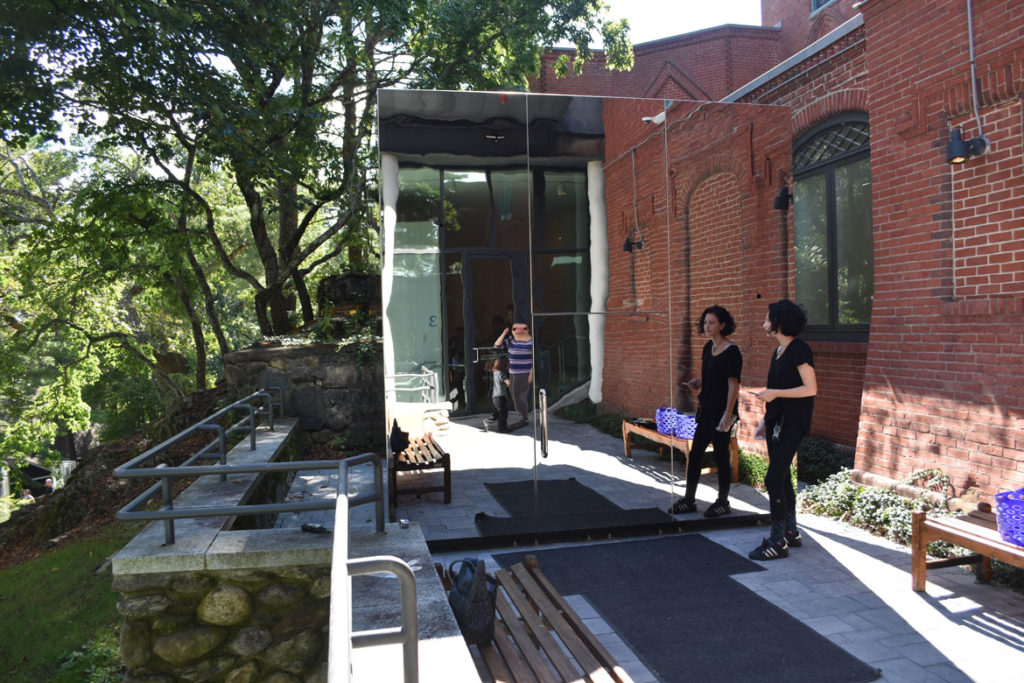
Queen of Love and Polka Dots
As the 1960s progressed, Kusama caused sensations and shock as she moved into happenings, protests, shenanigans. She ruffled feathers at the 1966 Venice Biennale when she filled a lawn with 1,500 mirrored plastic balls and dared to sell them one by one to visitors. Her sign read: “Your Narcissism for Sale.”
At “Body Festivals” and “Self-Obliteration” performances around New York in 1967 and ‘68, Kusama invited people to strip naked, then she painted them with polka dots. “Become one with eternity,” she wrote at the time. “Obliterate your personality. Become part of your environment. Forget yourself. Self-destruction is the only way out.”
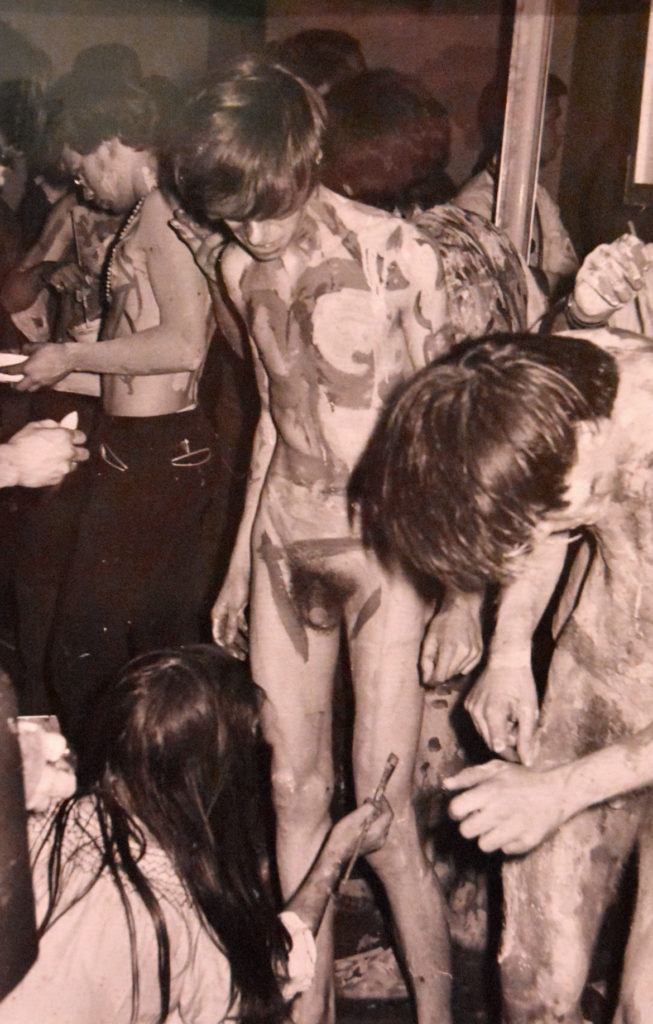
Kusama’s statements evoked the psychedelic quest for expanded consciousness of the late 1960s counterculture. “How about taking a trip with me out to Central Park where free tea will be provided under the magic mushroom of the Alice in Wonderland Statue,” Kusama wrote in the invitation to an August 1968 event. “Alice was the grandmother of the Hippies. When she was low, Alice was the first to take pills to make her high. I, Kusama, am the modern Alice in Wonderland. Like Alice, who went through the looking-glass, I, Kusama, (who have lived for years in my famous, specially-built room entirely covered by mirrors), have opened up a world of fantasy and freedom.”
Kusama hoped the nudity would help overturn New Yorkers’ “narrow-minded” views of sex. Then her events became increasingly politically charged. She presented what she billed as “the first Homosexual Wedding ever to be performed in the United States” at her “Church of Self-obliteration in 1968. At the United Nations building in New York that year, she washed a Soviet flag in protest of the Soviet invasion of Czechoslovakia.
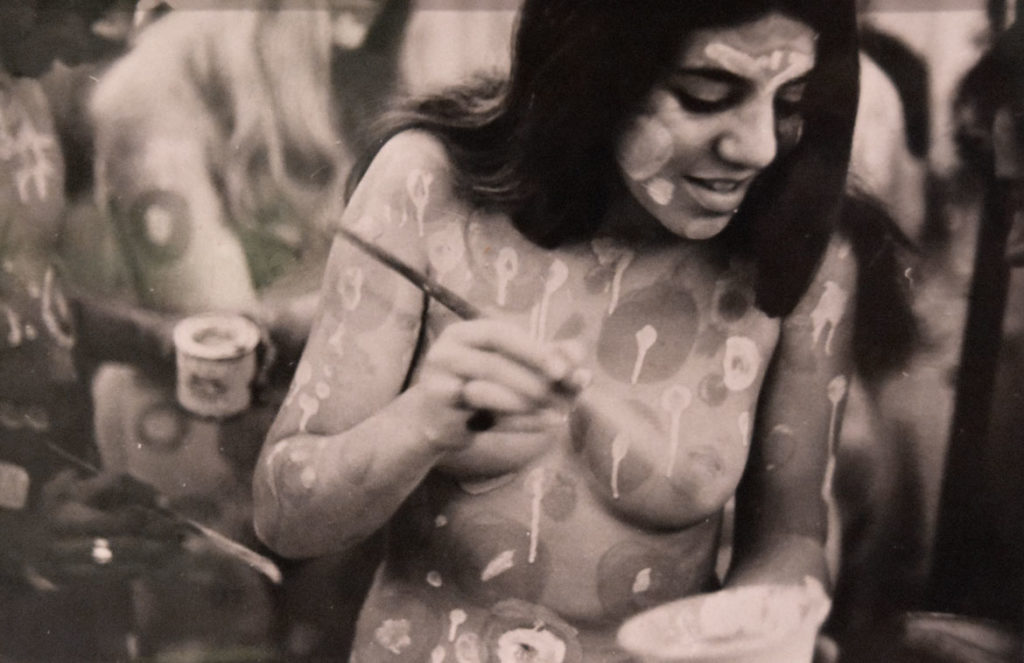
In 1968 and ’69, she staged protests in which naked people covered with dots danced to rock music in front of the Statue of Liberty (press release: “Take it off for liberty!”), on the New York subway, and in October 1968 at New York Stock Exchange (“Stock is a fraud! Obliterate Wall Street men with polka dots!”)
“Yayoi Kusama, a Japanese pop-op artist, wants the three presidential candidates to reveal the ‘bare facts’ about themselves,” The Boston Globe reported in November 1968. “She staged another of her ‘be-ins’ Sunday in front of the New York City board of elections office. Two girls and two men, wearing masks of the presidential candidates, took off their clothes while Miss Kusama painted red dots on their bodies to represent destruction of the ‘phony self.’”
Later that month, The New York Times reported “4 in Nude Protest the War in Vietnam” on Reade Street in lower Manhattan. Kusama daubed them with paint and they handed out an open letter to then President Richard Nixon saying: “Anatomic explosions are better than atomic explosions.”
“We’ve never been arrested,” one of Kusama’s collaborators told the reporter, “because the police can never get anyone in the crowd to complain.”
During the April 1969 “Love-In, Be-In” in New York’s Central Park, The New York Times reported, “the crowd was invited to watch the ‘spiritual wedding’ of Yayoi Kusama, a Japanese-born painter, and Louis Abolafia. After stripping, the couple announced Mr. Abolafia’s candidacy for Mayor on the ‘Love’ ticket.”
“Naked Protesters Burlesque Bronze Nudes at Museum,” The New York Times reported in August 1969. “Six young women and two men stripped off their clothes and cavorted for 20 minutes among the bronze and stone nudes in the garden of the Museum of Modern Art yesterday. … About 200 persons at the museum … watched as the live nudes struck poses parodying the statues.”
At this “Grand Orgy to Awaken the Dead” guerrilla happening, Kusama later recalled, “I did body painting while my models fucked a bronze sculpture by Maillol.”
Kusama called herself the “Queen of Love and Polka Dots,” the Times reporter said. “The group then walked up to the Bethesda Fountain at 72d Street in Central Park, where they again stripped and waded into the water.”
All the while, Kusama struggled with debilitating anxiety attacks.
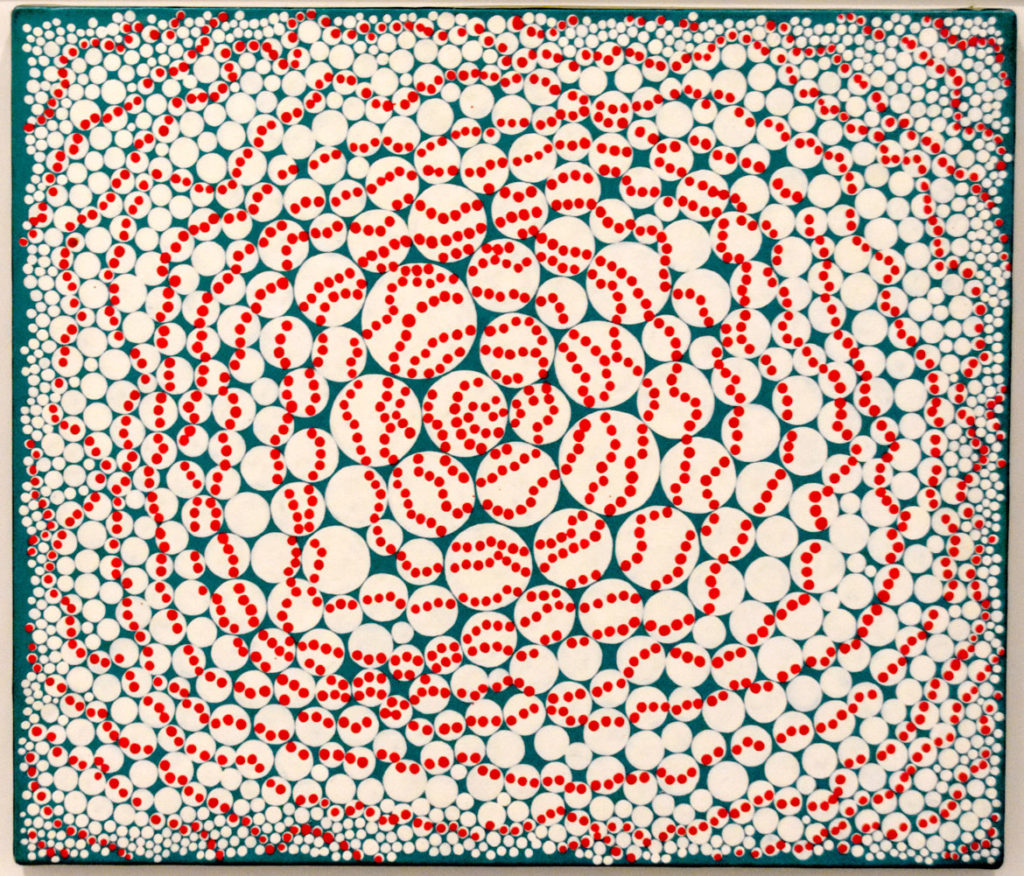
Back to Japan
In 1973, Kusama returned to Japan. She wrote short stories, poetry and novels (“Manhattan Suicide Addict,” 1978). She continued painting, sculpting and making installations. In 1977, she took up residence at the Seiwa Hospital in Tokyo, where she’d been getting periodic treatment for mental illness, while maintaining her own apartment and studio nearby.
Representing Japan at the 1993 Venice Biennale, Kusama covered a room with black dots on a yellow background. In the center of the room, was a mirrored box with a window high on one side. Visitors were invited to stand up on a step and look into see yellow papier-mâché pumpkins striped with black dots that seemed to repeat unto infinity inside the mirrored interior. Kusama attended the opening reception in a yellow and black polka dot robe and pointed witch hat and handed out little pumpkins.
This is about the time that white Western art institutions began to rediscover Kusama—as the institutions embraced bigness and immersive spectacle. Another of her mirrored rooms was showcased in the 2004 Whitney Biennial in New York. With the rise of social media, Kusama’s installations exploded in popularity as embodiments of perfect Instagrammable experiences.
How is real life different from social media? You walk into “Love Is Calling” and your eyes are blown out by Kusama’s psychedelic pyrotechnics. It’s a rush—like spinning upside down on a rollercoaster. But Kusama’s immense popularity has resulted in long lines, so the ICA only allows you two minutes inside. You hustle to snap photos before you have to exit. Behind Kusama reciting the poem, you can hear fans that keep the tentacles inflated. There’s a smell of rubber. Maybe you sense the boundaries, the edges of the room, the stagecraft. Mostly I feel hurried. I want to feel transcendence. But how can one experience infinity in just two minutes?
Sources:
• “Yayoi Kusama” by Laura Hoptman, Akira Tatehata and Udo Kultermann, 2000.
• “Season’s End: Abstractions and Distractions: Gigantism Way Out” by Brian O’Doherty, New York Times, June 17, 1962.
• “Art Notes: Biennale: Wanted: More Spaces for U.S. Exhibits” by Grace Glueck, New York Times, May 3, 1964.
• “The Art World: A ‘Colorless’ Show That Is Fascinating” by Edgar Driscoll, Boston Globe, Oct. 17, 1965.
• “The Art World: Multiplicity Now, Go-Round Next” by Edgar Driscoll, Boston Globe, April 24, 1966.
• “Names & Faces In the News”, Boston Globe, Nov. 4, 1968.
• “4 in Nude Protest the War in Vietnam,” New York Times, Nov. 12, 1968.
• “Kites, Fists Fly At ‘Love-In, Be-In’: Young Man Jumps Into Fire – 6 Others Arrested,” New York Times, April 7, 1969.
• “Naked Protesters Burlesque Bronze Nudes at Museum,” New York Times, Aug. 25, 1969.
• “Kusama’s Full Circle” by Chelsea Werner-Jatzke, SamBlog, Seattle Art Museum, July 6, 2017. Accessed Sept. 17, 2019. http://samblog.seattleartmuseum.org/2017/07/kusamas-full-circle/
Photos copyright 2019 Greg Cook.
If this is the kind of coverage of arts, cultures and activisms you appreciate, please support Wonderland by contributing to Wonderland on Patreon. And sign up for our free, weekly newsletter so that you don’t miss any of our reporting.
